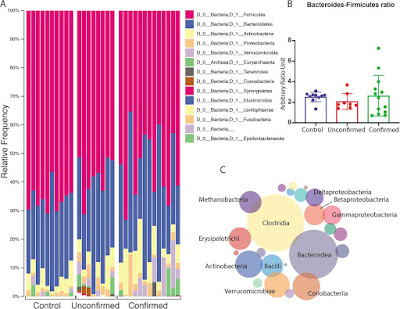Find out what the connection is with Sjogren's syndrome and our gut bacteria in this study...
Gut microbial dysbiosis in individuals with Sjögren’s disease
Roberto Mendez, Arjun Watane, Monika Farhangi, Kara M. Cavuoto,
Tom Leith, Shrish Budree, Anat Galor, View ORCID ProfileSantanu Banerjee
Tom Leith, Shrish Budree, Anat Galor, View ORCID ProfileSantanu Banerjee
doi: https://doi.org/10.1101/645739
Abstract
Purpose
To evaluate the gut microbiome in individuals with Sjögrens and correlate bacterial profiles to dry eye (DE) measures.
Methods
Prospective case series of individuals with confirmed (n=13) and unconfirmed (n=8) Sjögrens (n=21; total cases) as compared to healthy controls (n=10). Stool was analyzed by 16S pyrosequencing and associations between bacterial classes and DE symptoms and signs were examined.
Results
Firmicutes was the dominant phylum in the gut, comprising 40-60% of all phyla. On a phyla level, subjects with Sjögrens (confirmed and unconfirmed) had depletion of Firmicutes (1.1- fold) and an expansion of Proteobacteria (3.0-fold), Actinobacteria (1.7-fold), and Bacteroidetes (1.3-fold) compared to controls. Shannon’s diversity index showed no differences between groups with respect to the numbers of different operational taxonomic units (OTUs) encountered (diversity) and the instances these unique OTUs were sampled (evenness). On the other hand, Faith’s phylogenetic diversity showed increased diversity in cases vs controls, which reached significance when comparing confirmed Sjögrens and controls (13.57 ± 0.89 and 10.96 ± 0.76, p=0.02).
Using Principle Co-ordinate Analysis, qualitative differences in microbial composition were noted with differential clustering of cases and controls. Dimensionality reduction and clustering of complex microbial data further showed differences between the three groups, with regard to microbial composition, association and clustering. Finally, differences in certain classes of bacteria correlated with DE symptoms and signs.
Conclusions
Individuals with Sjögrens have gut microbiome alterations as compared to healthy controls. Certain classes of bacteria were associated with DE measures.
Our study findings are important as they set the foundation for modulating the gut microbiome as a potential therapeutic approach in Sjögren’s.
There are several ways to modulate the gut microbiome, including dietary intake, probiotics, and fecal microbial transplantation, researchers said.SEE FULL REPORT
My take on this study
It was a very small study so more larger studies are needed.
It found that people with Sjögren’s syndrome had significant changes in the composition of their gut bacteria.
Some of these changes seemed to be directly associated with eye dryness.
It adds to previous research that shows that people with auto-immune diseases have been found to have gut microbiome alterations, compared to healthy controls, including spondyloarthritis, rheumatoid arthritis, Behçets, and Sjögrens.
More information needs to be made available about altering the gut microbiome to a healthier one, using dietary intake, probiotics etc. so that individuals can do this themselves with the help of a medical professional.
I wonder what came first, the gut bacteria or the Sjogrens? Gut microbiome abnormalities can lead to systemic inflammation and systemic inflammation can deplete beneficial gut bacteria.
FIND OUT MORE ABOUT SJOGREN'S SYNDROME HERE:

Way cool! Some extremely valid points! I appreciate you writing this article plus
ReplyDeletethe rest of the site is extremely good.